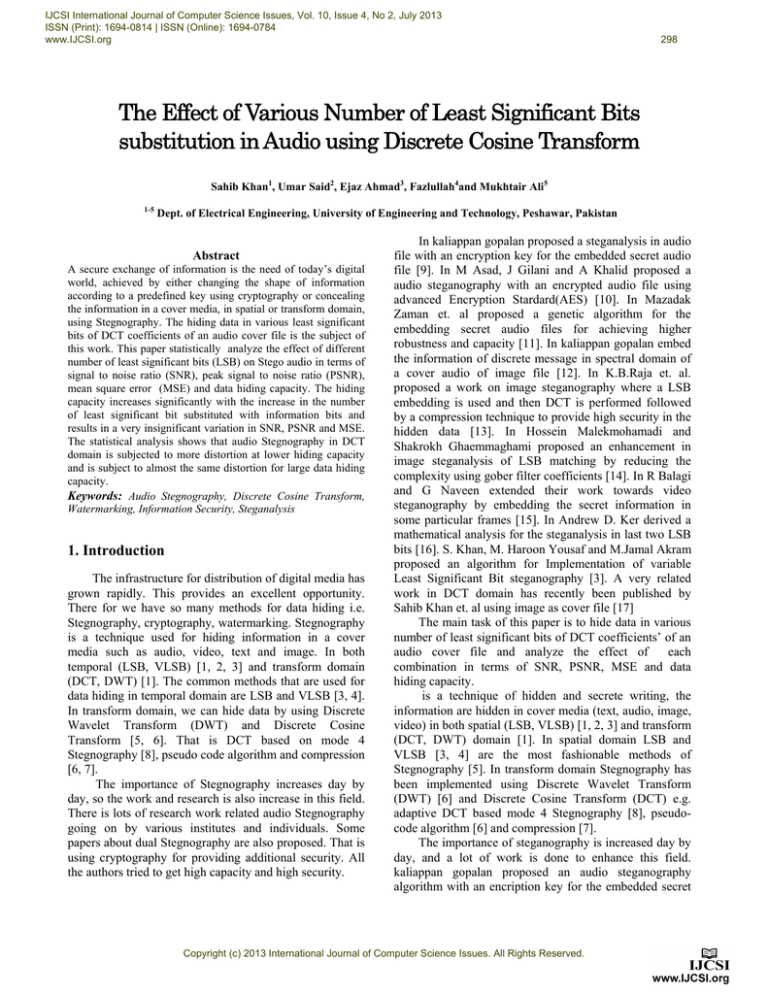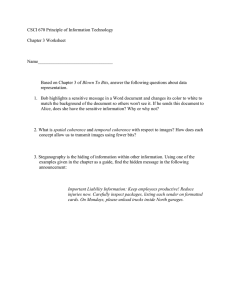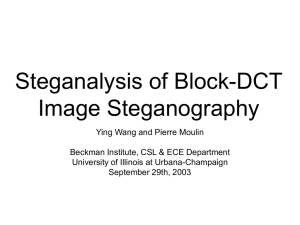
IJCSI International Journal of Computer Science Issues, Vol. 10, Issue 4, No 2, July 2013
ISSN (Print): 1694-0814 | ISSN (Online): 1694-0784
www.IJCSI.org
298
The Effect of Various Number of Least Significant Bits
substitution in Audio using Discrete Cosine Transform
Sahib Khan1, Umar Said2, Ejaz Ahmad3, Fazlullah4and Mukhtair Ali5
1-5
Dept. of Electrical Engineering, University of Engineering and Technology, Peshawar, Pakistan
Abstract
A secure exchange of information is the need of today’s digital
world, achieved by either changing the shape of information
according to a predefined key using cryptography or concealing
the information in a cover media, in spatial or transform domain,
using Stegnography. The hiding data in various least significant
bits of DCT coefficients of an audio cover file is the subject of
this work. This paper statistically analyze the effect of different
number of least significant bits (LSB) on Stego audio in terms of
signal to noise ratio (SNR), peak signal to noise ratio (PSNR),
mean square error (MSE) and data hiding capacity. The hiding
capacity increases significantly with the increase in the number
of least significant bit substituted with information bits and
results in a very insignificant variation in SNR, PSNR and MSE.
The statistical analysis shows that audio Stegnography in DCT
domain is subjected to more distortion at lower hiding capacity
and is subject to almost the same distortion for large data hiding
capacity.
Keywords: Audio Stegnography, Discrete Cosine Transform,
Watermarking, Information Security, Steganalysis
1. Introduction
The infrastructure for distribution of digital media has
grown rapidly. This provides an excellent opportunity.
There for we have so many methods for data hiding i.e.
Stegnography, cryptography, watermarking. Stegnography
is a technique used for hiding information in a cover
media such as audio, video, text and image. In both
temporal (LSB, VLSB) [1, 2, 3] and transform domain
(DCT, DWT) [1]. The common methods that are used for
data hiding in temporal domain are LSB and VLSB [3, 4].
In transform domain, we can hide data by using Discrete
Wavelet Transform (DWT) and Discrete Cosine
Transform [5, 6]. That is DCT based on mode 4
Stegnography [8], pseudo code algorithm and compression
[6, 7].
The importance of Stegnography increases day by
day, so the work and research is also increase in this field.
There is lots of research work related audio Stegnography
going on by various institutes and individuals. Some
papers about dual Stegnography are also proposed. That is
using cryptography for providing additional security. All
the authors tried to get high capacity and high security.
In kaliappan gopalan proposed a steganalysis in audio
file with an encryption key for the embedded secret audio
file [9]. In M Asad, J Gilani and A Khalid proposed a
audio steganography with an encrypted audio file using
advanced Encryption Stardard(AES) [10]. In Mazadak
Zaman et. al proposed a genetic algorithm for the
embedding secret audio files for achieving higher
robustness and capacity [11]. In kaliappan gopalan embed
the information of discrete message in spectral domain of
a cover audio of image file [12]. In K.B.Raja et. al.
proposed a work on image steganography where a LSB
embedding is used and then DCT is performed followed
by a compression technique to provide high security in the
hidden data [13]. In Hossein Malekmohamadi and
Shakrokh Ghaemmaghami proposed an enhancement in
image steganalysis of LSB matching by reducing the
complexity using gober filter coefficients [14]. In R Balagi
and G Naveen extended their work towards video
steganography by embedding the secret information in
some particular frames [15]. In Andrew D. Ker derived a
mathematical analysis for the steganalysis in last two LSB
bits [16]. S. Khan, M. Haroon Yousaf and M.Jamal Akram
proposed an algorithm for Implementation of variable
Least Significant Bit steganography [3]. A very related
work in DCT domain has recently been published by
Sahib Khan et. al using image as cover file [17]
The main task of this paper is to hide data in various
number of least significant bits of DCT coefficients’ of an
audio cover file and analyze the effect of
each
combination in terms of SNR, PSNR, MSE and data
hiding capacity.
is a technique of hidden and secrete writing, the
information are hidden in cover media (text, audio, image,
video) in both spatial (LSB, VLSB) [1, 2, 3] and transform
(DCT, DWT) domain [1]. In spatial domain LSB and
VLSB [3, 4] are the most fashionable methods of
Stegnography [5]. In transform domain Stegnography has
been implemented using Discrete Wavelet Transform
(DWT) [6] and Discrete Cosine Transform (DCT) e.g.
adaptive DCT based mode 4 Stegnography [8], pseudocode algorithm [6] and compression [7].
The importance of steganography is increased day by
day, and a lot of work is done to enhance this field.
kaliappan gopalan proposed an audio steganography
algorithm with an encription key for the embedded secret
Copyright (c) 2013 International Journal of Computer Science Issues. All Rights Reserved.
IJCSI International Journal of Computer Science Issues, Vol. 10, Issue 4, No 2, July 2013
ISSN (Print): 1694-0814 | ISSN (Online): 1694-0784
www.IJCSI.org
audio file [8]. Mazdak Zamani, Hamed Taherdoost,
Azizah A.Manaf, Rabiah B. Ahmad, and Akram M. Zeki
work on higher LSB layer of audio file to increased its
robustness [9]. Mohammad Pooyan, Ahmad Delforouzi
use lifting wavelet transform and calculate the hearing
threshold, and according to the threshold data bits are
embedded in the least significant bits (LSB) of lifting
coefficients [10]. Dimitriy E.Skopin, Ibrahim M.M. ElEmary, Rashad J.Rasras, Ruba S.Diab proposed an
algorithm in audio steganography for hiding human
speech signal using two methods spectrum shift and
spectrum spreading [11]. Masahiro Wakivama, Yasunobu
Hidaka, Koichi Nozaki work on wave file as an audio data,
and proposed two kinds of new methods of extended low
bits coding [12]. Haider Ismael Shahadi, Razali Jidin
proposed high capacity audio steganography algorithm
based on the wavelet packet transform with adaptive
hiding in least significant bits(LSB) [13]. Anupam Kumar
Bairagi, Saikat Mondal, Amit Kumar Mondal proposed a
method, the message bits are embedded into deeper layer
in such a way to increase its robustness [14].
Audio Stegnography is used to hide secret
information in audio cover file the secret message is
embedded by slightly altering the binary sequence of an
audio file. Existing audio Stegnography software can
embed message in WAV, AU and even MP3 sound files,
in both temporal domain and transform domain. In
transform domain Stegnography has been implemented
using DWT and DCT etc.
In all previously implemented techniques a specific
region/coefficients of the DCT are targeted and
data/information are hidden in the least significant bits of
specific DCT coefficients. This paper specifically deals
with LSB Stegnography using DCT. The main aim of this
paper is to find and analyze the effect and contribution of
each bit position on SNR and PSNR of Stego image in
DCT domain and also to make a comparison with the
effect and contribution of each bit position on SNR and
PSNR of Stego image in spatial domain.
2. Analysis Parameters
To analyze the effect of different number of least
significant bits in DCT coefficients of an audio cover file
the SNR, PSNR and MSE are calculated for each
combination of least significant bits and the data hiding
capacity for each combination is also calculated.
2.1. Hiding Capacity
299
The information hiding capacity for each combination of
least significant bits used is calculated using the
expression given.
N
(Cf
C
i
Bi )
i 1
N 8
100
Where
N: Size of Cover file
Bi: The number of bits hidden in a Coefficient
Cfi: The ith Coefficient
2.2. MSE, SNR and PSNR
The quality of Stego Audio file is analysed quantitatively
by calculating mean square error (MSE), signal to noise
ratio (SNR) and peak signal to noise ratio (PSNR). The
MSE, SNR and PSNR are calculated using expressions
given below [18, 19, 20].
2
MSE
1 R C
Cov(i, j ) Stego(i, j ))
R * C i 1 j 1
R C
Cov(i, j )2
i 1 j 1
SNR 10 * log10 R C
2
Cov (i, j ) Stego( I , j )
i 1 j 1
216 1
PSNR 10 * log10
MSE
3. Implementation
Hiding data in the least significant bits is a common
practice in both spatial domain and transform domain.
This work presented in this paper analyze the effect of
various number of least significant bits substituted in the
DCT coefficients of an audio file. An audio message file is
hidden in the least significant bits of the DCT coefficients
of cover audio file. The message and cover file are read at
the sampling rate of 44100 samples/s and 351800 samples
are captured almost equal to 3seconds play time in Matlab.
After reading/recording the cover file discrete cosine
transform (DCT) is applied on the cover audio file
resulting in a group of DCT coefficients. There is a
problem of negative values occurring in Matlab and the
DCT coefficients are scaled to avoid the negative values
and make all coefficients positive. The coefficients are
round off to fix the fraction part, by multiplying the DCT
coefficient with a suitable number, without any loss. For
Copyright (c) 2013 International Journal of Computer Science Issues. All Rights Reserved.
IJCSI International Journal of Computer Science Issues, Vol. 10, Issue 4, No 2, July 2013
ISSN (Print): 1694-0814 | ISSN (Online): 1694-0784
www.IJCSI.org
example after DCT we get a value 0.3528 then we
multiply it with 104 and get a whole number 3528. By
direct rounding off diffidently some will be lost which
avoided by the procedure adopted. Then information is
hidden in the specific least significant bits. The whole
process is explained in the block diagram in figure 1.
300
The time elapsed is also calculated for each combination
of least significant bits and is given in table 1. For
comparison the SNR, PSNR, MSE, Hiding capacity and
estimated time (elapsed time) for each combination of
LSBs are shown graphically in figure 2, figure 3, figure 4,
figure 5 and figure 6 respectively.
Table1. MSE, PSNR, SNR, Capacity and Processing Time vs LSBs
No of
LSBs
1LSB
SNR (db)
32.0691
PSNR MSE
(db)
(db)
83.7869 71.8334
Elapsed
time in sec
33.880674
Capacity
in %
5.8824
2LSBs
32.0690
83.7870 71.8320
35.138149
11.7647
3LSBs
32.0687
83.7872 71.8280
34.358654
17.6471
4LSBs
32.0684
83.7875 71.8228
34.249364
23.5294
5LSBs
32.0678
83.7881 71.8125
34.908435
29.4118
6LSBs
32.0666
83.7894 71.7920
34.769906
35.2941
7LSBs
32.0641
83.7918 71.7511
35.124846
41.1765
8LSBs
32.0591
83.7968 71.6688
35.267543
47.0588
32.07
32.068
32.066
32.064
32.062
32.06
Figure.1: Block diagram of Audio Stegnography in DCT
To make the analysis for various numbers of least
significant bits, data is hidden in 1LSB, 2LSBs, 3LSBs,
and 4LSBs and so on. For each combination of least
significant bits SNR, PSNR, MSE and hiding capacity are
calculated.
4. Experimental Results
To analyze the effect of various numbers of least
significant bits on SNR, PSNR, MSE and hiding capacity,
different numbers of least significant bits of the DCT
coefficients of audio file are modified according to the
message/information. For each combination of least
significant bits the quality measuring parameters and
hiding capacity is calculated. It can be clearly observed
from the experimental results that hiding capacity
significantly increases with the increase in number of least
significant bits to substituted in cover file as shown in
table 1 while the SNR, PSNR and MSE doesn’t changes
significantly with the increase in number of bits this trend
is quite opposite than that of using image as cover. The
values of SNR, PSNR and MSE are also given in table 1.
32.058
32.056
32.054
1LSB
2LSBs 3LSBs 4LSBs 5LSBs 6LSBs 7LSBs 8LSBS
SNR
Figure 2: SNR vs. No. of Least Significant Bits
83.798
83.796
83.794
83.792
83.79
83.788
83.786
83.784
83.782
83.78
1LSB 2LSBs 3LSBs 4LSBs 5LSBs 6LSBs 7LSBs 8LSBs
PSNR
Figure 3: PSNR vs. No. of Least Significant Bits
Copyright (c) 2013 International Journal of Computer Science Issues. All Rights Reserved.
IJCSI International Journal of Computer Science Issues, Vol. 10, Issue 4, No 2, July 2013
ISSN (Print): 1694-0814 | ISSN (Online): 1694-0784
www.IJCSI.org
301
5. Conclusion
71.85
Hiding data in different number of LSBs of DCT
coefficients of an audio cover file show a very significant
distortion in the cover file for less hiding capacity while
almost the same distortion is created for large data hiding
capacity of 47 %. The results of SNR, PSNR and MSE
show that Audio Stegnography in DCT domain is very
suitable for large data hiding instead of less data hiding
71.8
71.75
71.7
71.65
References
71.6
71.55
1LSBs 2LSBS 3LSBS 4LSBs 5LSBs 6LSBs 7LSBs 8LSBs
MSE
Figure 4: MSE vs. No. of Least Significant Bits
50
45
40
35
30
25
20
15
10
5
0
1LSBs 2LSBS 3LSBS 4LSBs 5LSBs 6LSBs 7LSBs 8LSBs
Hiding Capacity
Figure 5: Hiding Capacity vs. No. of Least Significant Bits
36
35
34
33
32
31
30
29
28
1LSBs 2LSBs 3LSBs 4LSBs 5LSBs 6LSBs 7LSBs 8LSBS
Time Elapsed
Figure 6: Time Elapsed vs. No. of Least Significant Bits
[1]. S. Dumitrescu, W.X.Wu and N. Memon, “On steganalysis
of random LSB embedding in continuous-tone images”,
Proc. International Conference on Image Processing,
Rochester 2002, NY, pp. 641-644.
[2]. S.K. Moon and R.S. Kawitkar,” Data Security using Data
Hiding”, International Conference on Computational
Intelligence and Multimedia Applications 2007, pp.247251.
[3]. S. Khan, M. Haroon Yousaf and M. Jamal Akram, “
Implementation of Variable Least Significant Bits
Stegnography using Decreasing Distance Decreasing Bits
Algorithm”, IJCSI Volume 8, Issue 6, November 2011.
[4]. Sahib Khan and Mohammad Haroon Yousaf,
“Implementation of VLSB Stegnography Using Modular
Distance Technique”, Innovations and Advances in
Computer, Information, Systems Sciences, and Engineering
Lecture Notes in Electrical Engineering Volume 152, 2013,
pp 511-525.
[5]. Neeta Deshpande, Kamalapur Sneha, Daisy Jacobs,
―Implementation of LSB Steganography and Its
Evaluation for various Bitsǁ Digital Information
Management, 2006 1st International Conference on.
06/01/2007; DOI: 10.1109/ICDIM.2007.369349
[6]. Sahib Khan and M. Haroon Yousaf, “Variable Least
Significant Bits Stegnography”. (Accepted for publication
in IJCSI Volume 8, Issue 5, September 2011.)
[7]. K.B. Raja, C.R. Chowdary, Venugopal K R, L.M.Patnaik,
“a secure image Stegnography using LSB, DCT and
compression technique on raw image” 0-7803-95883/05/$20.00 ©2005 IEEE
[8]. Muhammad Asad, Junaid Gilani, Adan Khalid, “ An
Enhanced Significant Bit Modification Technique for Audio
Steganography”, 2011 International Conference on
Computer Networks and Information Technology(ICCNIT),
pages 143-147
[9]. Gopalan., “Audio stegangraphy using bit modification”,
2003 IEEE international conference on Acoustic, speech
and signal processing page(s):II -421 -4 vol.2.
[10]. Muhammad Asad, Junaid Gilani, Adanan Khalid “An
Enhanced Significant Bit Modification Technique for Audio
Steganography”, 2011 international conference on computer
Networks and Information Technology (ICCNIT), pages
143-147
[11]. Zamani M., Manaf, A, Ahmad, R.B Jaryani, F., Taherdoost
H., Zeki, AM., “A secure audio steganography approach”,
Copyright (c) 2013 International Journal of Computer Science Issues. All Rights Reserved.
IJCSI International Journal of Computer Science Issues, Vol. 10, Issue 4, No 2, July 2013
ISSN (Print): 1694-0814 | ISSN (Online): 1694-0784
www.IJCSI.org
Internation Conference for internet Technology and Secured
Transactions 2009, page(s):1-6.
[12]. Kaliappan Gopalan, “A Unified Audio and image
Steganography by Spectrum Modification”, International
Conference on Industrial Technology, 2009, page(s):1-5
[13]. K B Raja , Chowdary C R, Venugopal K R, Patnaik L M
“A Secure Image Steganography using LSB DCT and
compression Techniques on Raw Images” 2005 IEEE
International conference on session B-image signal
processing.
[14]. Hossein Malekmohamadi and Shahrokh Ghaemmaghami
Reduced Complexity Enhancement Of Steganalysis of
LSB-matching Image Steganography” 2009 IEEE/ACS
International conference on computer system and
applications.
[15]. R Balagi, Naveen G”Secure Data Transmission Using
Video Steganography”, 2011 IEEE
International
conference on electro/information technology (EIT).
[16]. Andrew D.Ker,”Steganalysis of Embedding in Two LeastSignificant bits” 2007 IEEE transactions on information
forensics and security, vol.2 no.1, march 2007.
[17]. Dmitriy E.Skopin, Ibrahim M. M. EL-Emary, Rashad
J.Rasras, Ruba S.Diab, “Advanced Algorithm in Audio
Steganography for Human Speech Signal”.
[18]. http://www.mathworks.com
[19]. R.C. Gonzalez and R.E. Woods, 2008. Digital Image
Processing. Third Edition, Prentice Hall2008. ISBN:
013168728.
[20]. Sahib Khan, M. Nawaz Khan and Somia Iqbal, “Bit
Position based Qualitative and Quantitative Analysis of
DCT and Spatial Domain Stegnography”, IJCSI Volume 10,
Issue 3, May 2013
Engr. Sahib Khan got M.Sc. in
Telecommunication
Engineering
from
University of Engineering and Technology,
Taxila in the year 2012 and B.Sc. in
Telecommunication
Engineering
from
University of Engineering and Technology,
Peshawar in the year 2008. He currently
holds the position of Lecturer in the
Department of Electrical Engineering at
University of Engineering and Technology,
Peshawar. His research interests include Image and Signals
Processing, Information Security and Antenna designing. He,
along with his students, is developing and implementing
Stegnographic techniques and algorithms, esp. Image and Audio
Stegnography, in Spatial and Transform domains.
Copyright (c) 2013 International Journal of Computer Science Issues. All Rights Reserved.
302



